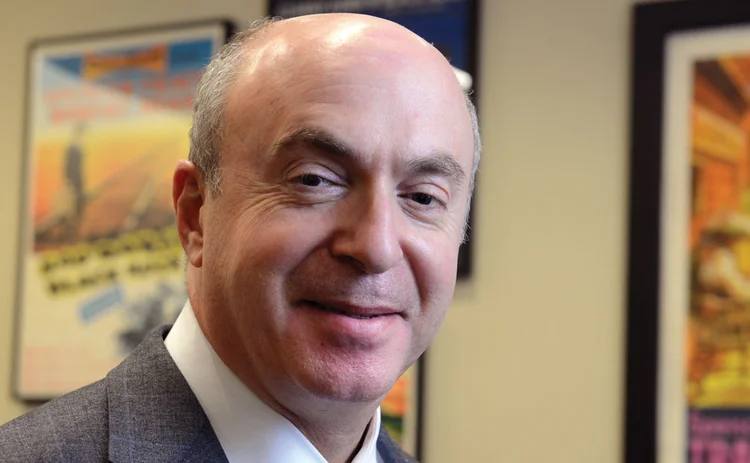
Lifetime achievement award: Bennett W Golub
CRO and founding partner has helped grow – and guard – BlackRock for almost three decades

One day at the height of the financial crisis – shortly after Lehman Brothers had collapsed in September 2008, but before a public bailout of other US banks – Bennett W Golub decided he had to get out of the office. He was experiencing a crisis of his own.
The BlackRock chief risk officer – one of its nine founding partners – had been doing some maths. As was the case across the asset management industry, investors were pulling money from BlackRock's institutional cash funds – tens of billions of dollars in that September alone – and the firm was finding it increasingly hard to come up with the required cash.
"I did the arithmetic in my head and it became apparent that without some form of intervention, market liquidity would evaporate. I thought the implications of that might be rioting in the streets."
Golub left BlackRock's office in midtown Manhattan and walked around the block twice – taking him into the autumn bustle of Park Avenue and Madison Avenue, and along the cross-streets with their dark bars and bright delis. And after that?
"I went back to my desk and did my job," he says. "In my entire career, it was the one day when the pressure almost got to me."
Ben realised very early on that liquidity – and more specifically, cash – was going to be a big part of getting through the crisis unscathed
Ed Fishwick, BlackRock
On the face of it, there is a fair amount of pressure. Golub is in charge of risk management at what is often described as the world's biggest financial company. As with all asset managers, sustained growth is the best testament to how well that job is being done – investors do not leave their money with serial failures – and BlackRock's assets under management hit $4.72 trillion in 2015. In the post-crisis period alone, they have almost quadrupled, and now represent roughly 13% of total assets under management in the US.
BlackRock insiders credit Golub with some of the key tactical decisions that saw the firm come through the crisis with its reputation enhanced.
"Ben realised very early on that liquidity – and more specifically, cash – was going to be a big part of getting through the crisis unscathed. Even in the summer of 2007, we talked many times about how, in extreme circumstances, your number one objective is to get to the other side with your clients safe, your reputation intact and still in business," says Ed Fishwick, managing director and global co-head of risk and quantitative analysis at BlackRock.
That insight was followed by a lot of unglamorous work – fund-by-fund assessments of redemption profiles and forecasts of liquidity needs, which resulted in many funds trading up in terms of quality to hold more liquid assets, or setting aside substantial cash buffers.
Golub rolled up his sleeves, Fishwick says: "That whole period from 2007 to 2009 was about taking an obsessive, granular approach to thousands of individual situations. It was a time when delegating was very difficult – it required an aggressive focus from every individual, and Ben led on that. It was too close for comfort at times, but his early insight was one of the key reasons we managed to do it."
I believe there are problems that did not happen because we were able to provide better information to people, helping them understand some of the financial risks that might otherwise have occurred
Bennett W Golub, BlackRock
BlackRock's success – and its sheer size – has brought scrutiny. Regulators are considering a prudential regime for systemically important asset managers; journalists have suggested the widespread use of BlackRock's risk analytics could produce dangerous herding; and politicians have questioned the potential for conflicts between BlackRock's role as investment manager and its role as adviser – via the BlackRock Solutions business Golub co-headed until 2009.
None of that dims Golub's pride about what the company has been able to achieve. As examples, he points to two of the engagements taken on by BlackRock Solutions in 2008: it provided valuations and advice that enabled JP Morgan to buy Bear Stearns in March that year, and was also engaged by the Federal Reserve Bank of New York to manage portfolios underwritten by the US taxpayer during the bailout of American International Group (AIG) three months later.
"I believe there are problems that did not happen because we were able to provide better information to people, helping them understand some of the financial risks that might otherwise have occurred," he says.
The Bear Stearns work had to be completed under huge pressure. The stricken investment bank had only survived the previous week thanks to an emergency loan, allowing it to limp to the weekend of March 15 – and a possible acquisition by JP Morgan.
 History records that the deal went through, but not that a key factor was the independent valuation BlackRock Solutions provided of a roughly $30 billion portfolio of agency mortgage-backed securities (MBS), collateralised mortgage obligations (CMOs), credit card asset-backed securities, subprime MBS and other securities. Starting at 8pm on Saturday, March 15, a team of 25 portfolio managers and modellers analysed and valued the Bear Stearns book, working through the night to conclude their work at 5pm the following day.
History records that the deal went through, but not that a key factor was the independent valuation BlackRock Solutions provided of a roughly $30 billion portfolio of agency mortgage-backed securities (MBS), collateralised mortgage obligations (CMOs), credit card asset-backed securities, subprime MBS and other securities. Starting at 8pm on Saturday, March 15, a team of 25 portfolio managers and modellers analysed and valued the Bear Stearns book, working through the night to conclude their work at 5pm the following day.
That allowed some big decisions to be taken. JP Morgan did not want the portfolio as part of the deal, and the New York Fed ultimately stepped in to acquire it via the first of its Maiden Lane vehicles – with JP Morgan taking a capped exposure to the assets of roughly $1 billion.
The firm's work on AIG was more involved – the insurer's bad assets ended up in Maiden Lane II and III, and BlackRock was given the mandate to liquidate them. It completed that job in 2012, earning a profit of $9.4 billion for the US taxpayer.
"There are many similar assignments not in the public domain that I can't mention – but these are two situations where we have really helped stabilise the financial system. More broadly, I think BlackRock Solutions has made it easier for entities to manage their own risks and come up with better results," says Golub.
It was the right firm at the right time. BlackRock's founder and chief executive, Larry Fink, left First Boston in 1988 after making – and losing – a fortune on CMOs. And Golub himself built one of the very first models used to trade CMOs. Those were the skills that prompted Fink to hire Golub in 1985, and later saw him ask the Massachusetts Institute of Technology (MIT) alumnus to join his start-up firm.
Golub was holidaying in Hawaii at the time, trying to relax and forget work after a stressful end to the year: it was his wife, reading The Wall Street Journal, who told Golub his boss had left First Boston.
The ability to manage a gigantic pool of assets effectively would not be possible without the Aladdin platform and the intellectual structure that sits around that. Ben has been a major architect of that since the inception of the firm
BlackRock senior risk manager
"That got my attention. I wound up calling into New York and eventually spoke to one of my colleagues – Rob Kapito, now the president of BlackRock – and he said 'Where are you? Larry's left First Boston and he'd like you to call him because he'd like you to come along'."
It was a good decision by both parties. Golub brought with him one of the key strategic insights that supports the firm's now-mammoth scale, says Fishwick – the need for the central, scalable portfolio analytics platform that BlackRock calls Aladdin.
"The ability to manage a gigantic pool of assets effectively would not be possible without the Aladdin platform and the intellectual structure that sits around that. Ben has been a major architect of that since the inception of the firm," says one of BlackRock's senior risk managers.
The platform is also used by around 175 client organisations, and this aspect of Aladdin has worried some observers. Both the Financial Times and The Economist have suggested it could be a source of instability by encouraging herding. The latter was first to the punch, fretting in December 2013 about "groupthink", finding a "disturbing parallel" with the rating of securitised mortgage debt, and warning "too many investors relying on a single model spreads an unhealthy orthodoxy".
Golub does not see it. He argues the sophisticated investors using Aladdin as part of their investment process have a variety of ways to measure risk – including internally developed models and spreadsheets, prolific dealer research, high-quality risk analytics from firms such as MSCI, and the models and analytics built into the near-ubiquitous Bloomberg terminal. On its own, Aladdin could not convince a varied assortment of investors, each with their own mandates, investment styles and portfolios, to do the same thing at the same time, Golub says.
 "There is a tremendous variety of tools out there, so the idea that you would somehow provoke herding – and I say this without any reservation – is inconceivable. I see no realistic way in which it could ever be true with responsible investors," he says.
"There is a tremendous variety of tools out there, so the idea that you would somehow provoke herding – and I say this without any reservation – is inconceivable. I see no realistic way in which it could ever be true with responsible investors," he says.
Mass redemptions, of course, do happen – and one of Golub's current goals is to find ways of tackling systemic liquidity risk.
It would be helpful, Golub says, if it was possible for a liquidity failure to be graceful, rather than catastrophic – essentially meaning in rare circumstances investors might get their money back a day or two later than they had been hoping. That is a dispensation explicitly granted to Ucits funds by European law.
"In 2007, we had a Ucits fund that faced a large redemption. The portfolio managers determined it would not be in the interests of the fund's shareholders to make the full redemption in one day. The fund's prospectus supported that, as the requested redemption was above a defined threshold. Therefore, the redemption amount was partially curtailed – and the remainder of the redemption was fulfilled the following day. There was no crisis, the fund continued to operate, and the fund's investors were better off," he says.
If the same flexibility was afforded to other vehicles, Golub argues the system as a whole would benefit: "Of course, this would first require that fund investors understand this can happen; there is no lender of last resort in securities markets, and one of the reasons you earn a return on a financial asset is because you bear varying degrees of liquidity risk," he says.
This truth is currently concealed from investors in US open-end mutual funds, who are told they will get back every dollar they invest, and will also be given the full value of their shares at the point they make a withdrawal request.
By externalising the transaction costs, you improve the returns to the long-term investor
Bennett W Golub, BlackRock
As Golub saw in the days that followed the Lehman collapse, there are times when these promises are hard to honour – when redemptions become pro-cyclical, piling up selling pressure in a market that is unable to facilitate it, and adding to the strain on the system. It's why Golub and BlackRock support recent proposals from the US Securities and Exchange Commission (SEC) that would allow mutual funds to pass on transaction costs incurred when liquidating positions. In theory, more investors will sit tight during periods of stress if they face a cut in the value of their shares when redeeming. Golub describes the practice – known as swing pricing – as "a particularly brilliant innovation".
On January 13, BlackRock sent a 44-page comment letter to the SEC, offering broad support for the proposal and other liquidity risk measures outlined in the agency's September 22 consultation.
"It creates some operational challenges that have to be worked out in the US fund market, but it also means we're no longer going to pretend the transaction costs associated with redemptions do not exist – we would remove that existing shroud. That can only be a good thing for the markets," Golub says. "By externalising the transaction costs, you improve the returns to the long-term investor, and it also allows market participants to actually make decisions based on approximately knowing those costs. That necessarily can only reduce the pro-cyclicality that potentially exists in a redemption cycle."
The operational challenges are significant. The BlackRock letter notes it will take an estimated two years for the mutual fund industry to make the required technology and infrastructure changes to support swing pricing, citing work done by the Global Association of Risk Professionals (Garp). That work was taken up at Golub's suggestion – he has been part of Garp's board since 2010.
There are also philosophical challenges: a small investor who happened to make a redemption request on the same day as a very large investor might take a hit as a result. Golub's argument is that the overriding principle is the key – investors should be free to redeem when they want, but should also have to face the costs. Big and small investors alike will ultimately benefit, he says, and a large – but loose – coalition of asset managers "has come together in support of swing pricing".
These momentous, market- and business-defining decisions feel a long way from Golub's middle-class upbringing in Brooklyn and Long Island. His father – a Polish immigrant and Holocaust survivor – was a purchasing agent for a small metal-stamping company; his mother worked as a phlebotomist.
In fact, in at least two ways, Golub seems to have carried that background into his career. He says his father's experiences in the war were a pervasive element of his childhood – his father had suffered severe frostbite to his feet and was physically limited in what he could do. There was a sense that safety was not guaranteed, that the world as Golub knew it could be more fragile than it seemed.
"How did it affect my world view? I don't assume the world is necessarily always rational, or that there are boundaries on behaviour, and that it's not just a flight of fantasy to imagine very bad things happening. I don't have any problem imagining left tails – I see them, I feel them – I'm always looking out for left tails," he says.
He also speaks with feeling about what he calls the most important work BlackRock does – essentially, looking out for retail investors who are planning for life's big events.
 "Taken as a whole, I really do think we have been able to make the world a better place, and I say that wary of the fact that it opens me up to ridicule – because in today's perhaps rightly cynical world, people are reluctant to recognise any social good that arises from the financial industry," he says. "We certainly owe it to our clients, who have entrusted us with the dreams for the future, to be competent fiduciaries."
"Taken as a whole, I really do think we have been able to make the world a better place, and I say that wary of the fact that it opens me up to ridicule – because in today's perhaps rightly cynical world, people are reluctant to recognise any social good that arises from the financial industry," he says. "We certainly owe it to our clients, who have entrusted us with the dreams for the future, to be competent fiduciaries."
That is only possible as part of a strong team, of course, and Golub pays tribute to former colleague, Charlie Hallac, one of BlackRock's earliest employees. Hallac died in September last year following a long fight with cancer.
"In 2001, Charlie and I were honoured by Risk magazine as Asset management risk managers of the year. In my view, BlackRock could never have achieved its current scale and scope absent his uncompromising quest to 'Aladdinise' our entire investment processes with such intensity. Charlie created the platform that let BlackRock do what it does in risk management," he says.
The two men were close; Golub describes Hallac as his best friend.
Golub also makes special mention of Ed Fishwick, who joined the firm in 2006 as part of BlackRock's acquisition of Merrill Lynch Investment Managers – the two currently co-head the risk and quantitative analysis group at BlackRock. "Ed has a very deep understanding of equity markets combined with excellent business judgment and world-class communications skill. I could not do what I do without Ed doing what he does, and he's a very important part of the success of the risk management function here," he says.
Only users who have a paid subscription or are part of a corporate subscription are able to print or copy content.
To access these options, along with all other subscription benefits, please contact info@risk.net or view our subscription options here: http://subscriptions.risk.net/subscribe
You are currently unable to print this content. Please contact info@risk.net to find out more.
You are currently unable to copy this content. Please contact info@risk.net to find out more.
Copyright Infopro Digital Limited. All rights reserved.
As outlined in our terms and conditions, https://www.infopro-digital.com/terms-and-conditions/subscriptions/ (point 2.4), printing is limited to a single copy.
If you would like to purchase additional rights please email info@risk.net
Copyright Infopro Digital Limited. All rights reserved.
You may share this content using our article tools. As outlined in our terms and conditions, https://www.infopro-digital.com/terms-and-conditions/subscriptions/ (clause 2.4), an Authorised User may only make one copy of the materials for their own personal use. You must also comply with the restrictions in clause 2.5.
If you would like to purchase additional rights please email info@risk.net
More on Awards
Trading systems: structured products/cross-asset – Murex
Murex won the Trading systems: structured products/cross-asset award at the 2025 Risk Markets Technology Awards for its MX.3 platform, praised for its flexibility and advanced analytics
Best vendor for system support and implementation: Murex
Murex has won the Best vendor for system support and implementation at the Risk Markets Technology Awards, recognised for its innovative MX.3 platform, exceptional client support and seamless implementation services
FRTB-IMA product of the year: Murex
Murex wins FRTB-IMA product of the year for its advanced, scalable MX.3 platform enabling seamless regulatory compliance
Pricing and analytics: equities – Finastra
Finastra’s Sophis platform wins the Risk Markets Technology Award for Pricing and analytics in equities, recognised for its robust capabilities in equities and derivatives trading
Best execution product of the year: Tradefeedr
Tradefeedr won Best execution product of the year for its API platform, which standardises and streamlines FX trading data, enabling better performance analysis and collaboration across financial institutions
Collateral management and optimisation product of the year: LSEG Post Trade
LSEG Post Trade wins Collateral management and optimisation product of the year for interconnected services that help mitigate counterparty risk and optimise capital usage
Clearing house of the year: LCH
Risk Awards 2025: LCH outshines rivals in its commitment to innovation and co-operation with clearing members
Driving innovation in risk management and technology
ActiveViam secured three major wins at the Risk Markets Technology Awards 2025 through its commitment to innovation in risk management and technology







